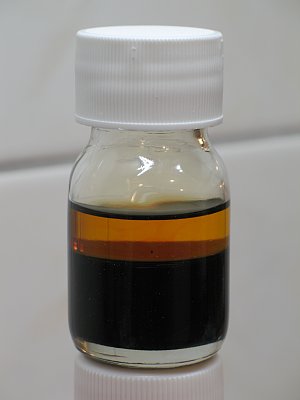


Preparation and distillation of Br2
In this experiment, bromine is made from sodium bromide, potassium bromate and sulphuric acid, and the bromine is distilled and stored under sulphuric acid. Approximately 90% of all bromine could be isolated in pure liquid form.
The following chemicals were used:
- potassium bromate, 17 grams
- sodium bromide, 50 grams
- sulphuric acid, 40 grams
The quantities of potassium bromate and sodium bromide are chosen, such that the molar ratio of these is close to 1 : 5, with a slight excess of potassium bromate. The reaction equation is as follows:
KBrO3 + 5NaBr + 6H+ → 3Br2 + K+ + 5Na+ + 3H2O
The amount of acid is taken, such that appr. ⅓ part of it is in excess. This excess acid makes the reaction much smoother and assures quantitative conversion of bromide to bromine.
![]()
Preparation of mix, which produces the bromine to be distilled
The initial mix, used for distilling the bromine is the following:
- dissolve the NaBr in cold tap water, such that approximately 80 ml of solution is obtained;
- mix the sulphuric acid with tap water, such that another 100 ml of liquid is obtained, and allow to cool down;
- mix the dilute acid with the solution of NaBr and put this all in a 500 ml round bottom flask, which also will be used during distillation;
- make a fine powder of the KBrO3 and slowly add this to the mix of acid and NaBr, while swirling the liquid;
- carefully rinse with more water, such that no solid KBrO3 remains on the ground glass joint of the 500 ml round bottom flask;
- add some small boiling stones to the mix;
- the round bottom flask now contains approximately 250 ml of liquid, with some finely powdered KBrO3 at the bottom, and already a lot of Br2 vapor above the liquid;
- attach the round bottom flask to the distillation setup and immerse in a water bath, which will be carefully brought to boiling.
![]()
Setup of distillation apparatus
The distillation setup is an all-glass setup, with ground glass joints, which were degreased and cleaned before assembling the apparatus. A 500 ml round bottom flask contains the mix as described above. This is heated in a water bath in order to drive off the bromine.
The bromine vapor is lead through a liebig condenser, which is cooled with slowly running tap water and on the other side of the liebig condenser, a 250 ml round bottom flask is attached.
The distillation setup, used in this experiment, can be used for vacuum distillation. In this setup, however, a security tube is attached to the connector, which normally is used for connection to a vacuum pump. During the distillation of the bromine, quite some bromine vapor can be produced and for this reason, a tube was attached to the distillation setup and this tube is lead into a solution of NaOH for absorbing bromine vapor. Ideally, this tube would not be necessary, but it was added, just for extra safety. During the experiment, it appeared that indeed it was a good idea to add this tube!
The total setup in action looks as follows:

The large round bottom flask is filled completely with bromine vapor, even without heating. It is attached to an all-glass distillation setup, with all joints being degreased and cleaned before assembling the apparatus. When the water bath is brought to a slow simmering, then the bromine in the solution quickly boils over to the collector flask. Also some water vapor is taken into the collector flask.
The thermometer nicely shows a temperature of 57 to 58 şC, which indeed is close to the boiling point of bromine. Only after some time, when hardly any bromine goes over to the collector flask, the temperature is rising slowly, to well over 63 şC.

The collector flask contains the bromine, but unfortunately, also some water is going into this flask.

After the distillation, the contents of the collector flask is transferred to a small 30 ml bottle, which has a cap, with a PTFE liner. After transferring and settling some time, one can see that the bromine is covered by a very thin layer of water near the glass wall. Most of this water can be pipetted away with a pasteur pipette.
The bromine can easily be dried by pouring a few ml of concentrated sulphuric acid on it, carefully shaking and then pipetting away the bromine from under the acid. I, however, decided to keep the bromine under the sulphuric acid. Storage of the bromine then is easier, because of the much lower emission of bromine vapor from the bottle. The final yield is 14 ml of bromine. The picture shows the 30 ml bottle, with the bromine in it and the layer of sulphuric acid above it. Above the sulphuric acid, there is some bromine vapor, but it is not as much as one would have without the layer. On storage, the bromine vapor above the acid will become more dense, but only very slowly. Hardly any acid will dissolve in the bromine, it can actually be regarded as perfectly dry and for any practical purpose, it can be regarded free of acid. The two pictures below show the bromine with the acid above it, just one hour after bottling, and three days after bottling.

